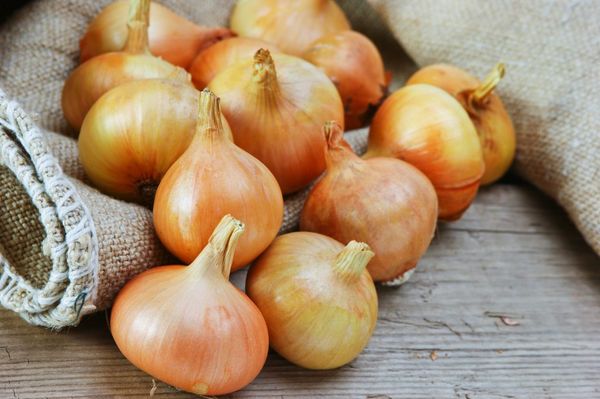It is quite simple to grow quality onion heads from sevka, especially since the technology has many advantages. There is a high productivity, rapid ripening of root crops, the release of arrows occurs less often than when growing turnips. With proper care, planting in the open field does not cause difficulties.
Sowing sevok in the country can be in the northern regions, Siberian regions and Novosibirsk. It is important to observe the rules of sowing, care properly and protect against frost.
Table of contents
The correct time for planting onion sevka in open ground
The optimal period of the landing work - end of april. The early period is due to the resistance of the culture to cold. Also used is a method of growing onions from a tree planted before winter (in the second half of October).
Planting sevka at a later time leads to a rapid drying of the upper layer, as a result of which the soil quickly loses the moisture accumulated during the winter. This negatively affects the rooting of the bulbs, which delays the emergence of shoots. As a result, roots are not fully mature.
Seeding planted in the Urals and in the regions of Siberia since the beginning of May (with 5-10 numbers) when the soil temperature is from +7 degrees.
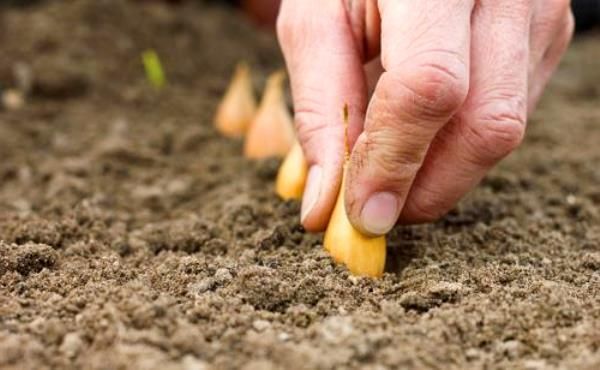
Methods of growing and planting onions
Place under the beds is selected well sunlit and ventilated. It is necessary for normal growing season, eliminating the formation of rot and fungal diseases.
The soil is suitable light fertile with neutral or weakly acidic medium. To reduce the acidity, lime is introduced into the soil (up to 4-5 kg per hundred parts). Also suitable for these purposes: dolomite flour, wood ash, crushed chalk.
There is no need to break up the beds at the place where garlic is grown, the land after the savory culture is very depleted, which will reduce the onion harvest. But after tomatoes, eggplants, pumpkins, cereals and potatoes, you can plant sevok.
When enriching the soil with fertilizers, it is not necessary to simultaneously introduce lime into it, as this leads to a significant decrease in the amount of nitrogen. And it is necessary for normal growing season.
When preparing the beds for onions in the fall, humus (up to 5 kg per m2) is added to the plot. In the course of work, the earth is dug up to the depth 20 cm. Spring work begins with cleaning the area from debris and fertilizing the soil with minerals. Superphosphate (6 g / m 2), urea (1 g / m 2), potassium chloride (2 g / m 2) are scattered on the ground and cultivated.
An obligatory preparatory stage is the disinfection of the soil.To do this, 7 days before disembarking, it is poured over with a solution of blue vitriol (a tablespoon of money in a bucket of water).
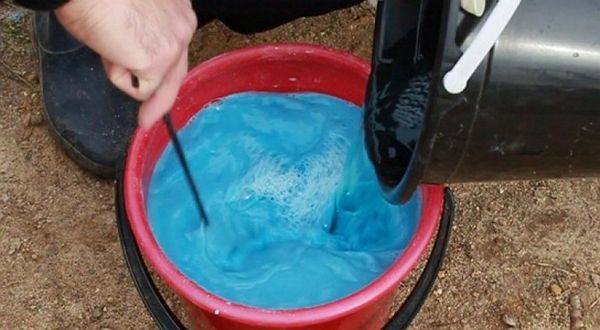
Planting material also needs to be disinfected before planting. Proper preparation affects yield and crop resistance to diseases and pests. Seeding consists of the following steps:
- soaking in a weak solution of potassium permanganate (copper sulphate 0.35%);
- drying followed by storage for 20 days at a temperature +20 degrees;
- heating the heads for 10 hours at a temperature +40 degrees;
- seed treatment with growth stimulant.
Onion Sevok is grown in several ways:
- in the spring;
- before winter;
- in the greenhouse;
- bridge method.
Spring in the garden
Spring disembarkation is made according to the scheme:
- interrow width at manual processing of beds - 25 cm (in the presence of motoblock - 60-72 cm);
- hole spacing - from 5 to 10 cm;
- immersion depth - 3-4 cm.
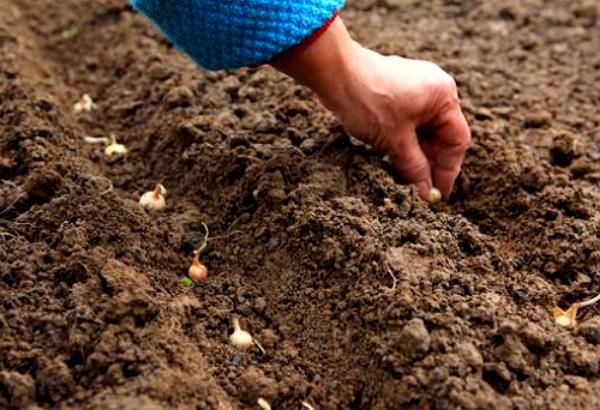
After planting, the bed is mulched with a layer (2-3 cm) of peat, paper, sawdust, or other suitable materials.
Before the winter to the soil
The method of landing sevka for the winter has several advantages:
- there is no need to ensure the storage conditions of the set in the winter period until the middle of spring;
- early terms harvest (mid-July);
- by the time pests appear, the culture is quite mature and mature.
On the vacant place you can have time to grow the harvest of some fruits with a short period of ripening.
The peculiarity of the choice of the place for the bed is in the preference of the site located on a hill. There, the snow melts faster, moreover, the stagnation of melt water is excluded.
The landing time is from October 5 to 20. Planting material should be properly prepared: calibrate, disinfect and heat. The scheme is used standard or with a narrow aisle. up to 15 cm. Sealing depth is 5 cm.
With the onset of cold weather, the surface of the bed is covered with mulch material. In the spring of the old protective layer must be removed.
In the greenhouse
Growing seed in a greenhouse includes a number of preparatory activities:
- disinfection of construction surfaces;
- loosening the soil;
- introduction of humus (5 kg per 1 m2);
- fertilizer beds with minerals (superphosphate - 30 gr., potassium chloride - 15 gr.);
- mixing and leveling the ground.
Seed material is selected with a diameter of 30-50 mm. Any bad material is discarded. in the second half of October according to the scheme:
- distance between the heads - 20-25 cm;
- immersion depth - 4 cm.
On top of the beds, mulch of straw or sphagnum moss is covered with a layer up to 20 cm.
Spring work begins with the cleaning of the mulching material before planting and growing. Then fertilizers of nitroamofoska (up to 15 g / m2) are introduced twice. Irrigation is done as needed. Actively begin to rise in mid-April and early May. When the height of the pen reaches 20 cm, the crops are harvested.
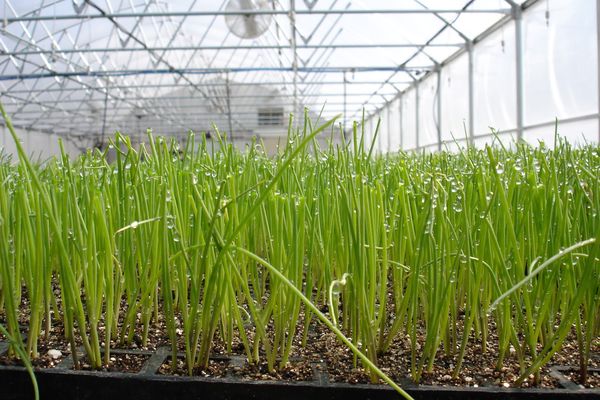
Mostovoy
This method of growing onions on the feather is used more often on balconies or in small greenhouses. The essence of the technology lies in the deepening of sevka in the ground in one row at the minimum rate without intervals between heads. Thus, it turns out the bridge, which served as the name of the method.
From bait is recommended to use:
- superphosphate and potassium chloride - 2 g / 10 l of water;
- ammonium nitrate.
Baits are introduced on the 8th and 14th day of the growing season.
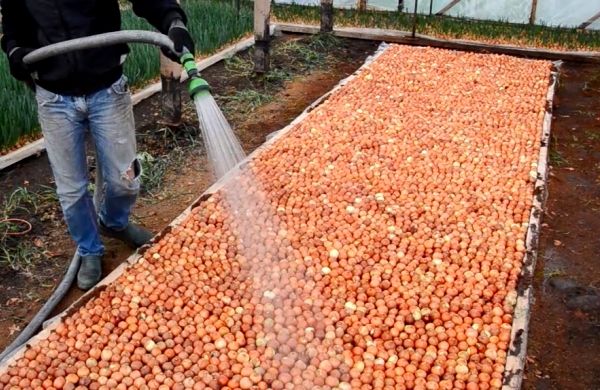
When rises
When growing seed on open ground during spring planting, seedlings appear above the soil surface on days 9-11. If the landing work was carried out in October, then the first green is breaking through, depending on weather conditions, more often it occurs in early to mid-April.
Greenhouse cultivation also guarantees different timing of emergence of seedlings, due to the type of construction and thermal conductivity of its surfaces. In the most common polycarbonate greenhouse you can see the greening soil from the soil at the end of February and the beginning of March.
When using the bridge cultivation method, the first shoots can be obtained 5-6 days after disembarkation.
How to care and loosen
After emergence of shoots above the ground surface every 2 weeks to loosen the soil in beds to prevent earth formation.
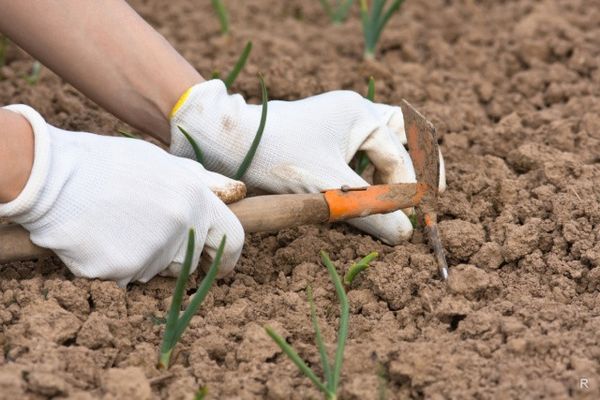
This process is often combined with weeding to remove weeds, which creates favorable conditions for disease and rotting onions. Moreover, this neighborhood contributes to the formation of a thick neck, which subsequently complicates the drying of the crop.
Onion refers to the cultures that can do without bait, but this is when the soil is fertile. Many gardeners use 2-3 one-time bait mode:
- 20-25 days after planting the seeding is carried out by watering with a solution of manure (1 kg per bucket of water);
- application of mineral fertilizers (urea, nitrophoska) before irrigation.
Watering the beds is carried out with strict control of soil moisture. Lack of moisture is just as unacceptable as its abundance. If you carefully observe the plant, you can understand what the slightest changes indicate.Water should not be salty, when contaminated need to be slightly drained from the bucket.
The appearance on the leaves of a bluish-white shade indicates insufficient watering, and the paleness of feathers indicates an abundance of moisture. The first couple of months sevok irrigated weekly (7-8 liters per 1 m2). Since July, the amount of water is reduced, and 3 weeks before harvest, it stops altogether.
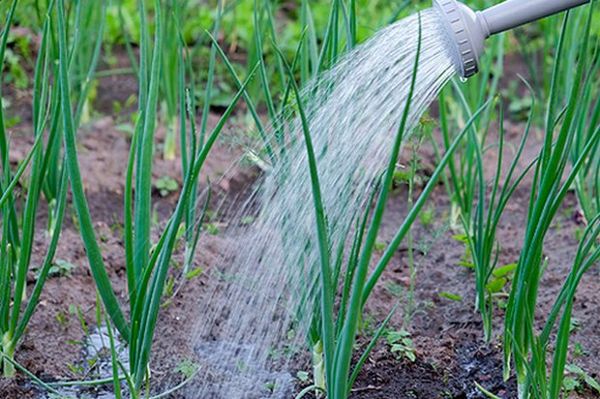
200 grams of salt is taken into a bucket of water, the amount of liquid should be prepared at the rate of 300 ml per bush. The procedure is repeated. 1 time in 3 weeks. If the treatment was ineffective, the concentration should be increased to 450 g / 10 l of water.
Is it afraid of frosts and what temperature can withstand
Onions are afraid of freezing and night temperatures below zero. The temperature indicators of the air at the landing should be within +12 degrees, the soil at a depth of 10 cm - not less than +5 degrees. Planting material germinates at 4-5 degrees. Mature onions of specially selected varieties withstand frost down to -7 degrees, while sweet varieties die at -4 degrees.
Onion care is quite simple, if done properly preparatory work. Monitoring the state of the feather of the plant will be a hint, and the plan of measures will not let you forget about important procedures that guarantee a high yield.
